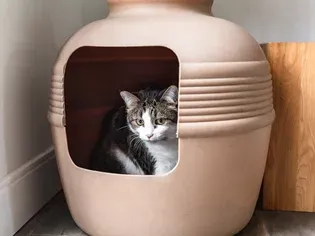Blood in Cat's Stool
Updated on 04/26/24

Blood in Your Cat's Stool: A Comprehensive Guide to Understanding Causes, Diagnosis, and Treatment
Introduction
Blood in a cat's stool, medically termed hematochezia, is a distressing sight for any cat owner. It can be a sign of a wide range of underlying medical conditions, some of which can be life-threatening if left untreated. Understanding the potential causes, diagnostic procedures, and treatment options is crucial for ensuring your cat's health and well-being. This comprehensive guide will delve into everything you need to know about blood in cat stool, empowering you to make informed decisions and provide the best possible care for your feline companion.
Potential Causes
The presence of blood in a cat's stool can stem from various causes, including:
* Gastrointestinal Tract Inflammation: Inflammatory bowel disease (IBD), pancreatitis, and other digestive tract disorders can cause irritation and bleeding.
* Infections: Bacterial, viral, or parasitic infections, such as giardia, roundworms, or hookworms, can damage the intestinal lining, leading to blood in the stool.
* Ulcers: Erosions in the stomach or intestinal lining, often caused by stress, medications, or certain foods, can bleed into the stool.
* Hemorrhoids: Enlarged, inflamed veins in the rectum can rupture and cause blood in the stool.
* Trauma: Injuries to the gastrointestinal tract, such as from swallowing foreign objects or blunt force trauma, can cause bleeding.
* Cancer: Malignant tumors in the digestive tract can bleed into the stool.
Diagnostic Evaluation
To determine the underlying cause of blood in your cat's stool, your veterinarian will conduct a thorough diagnostic evaluation, including:
* Physical Examination: A comprehensive physical exam will assess your cat's overall health, including their abdomen and rectal area.
* Medical History: Your veterinarian will discuss your cat's symptoms, diet, and recent activities to gather clues about potential causes.
* Fecal Examination: A stool sample will be examined under a microscope to detect parasites, bacteria, or inflammatory cells.
* Blood Tests: Bloodwork can reveal infections, anemia, or other underlying conditions.
* Imaging Studies: X-rays or ultrasound may be used to visualize the gastrointestinal tract and identify structural abnormalities or tumors.
* Biopsy: In some cases, a biopsy of the intestinal tissue may be necessary to confirm a diagnosis.
Treatment Options
The treatment plan for blood in cat stool depends on the underlying cause and may include:
* Dietary Modifications: For dietary sensitivities or allergies, your veterinarian may recommend a hypoallergenic or prescription diet.
* Medications: Antibiotics, anti-inflammatories, or other medications may be prescribed to treat infections, reduce inflammation, or control bleeding.
* Surgery: In cases of severe trauma, hemorrhoids, or tumors, surgery may be necessary to address the underlying issue.
* Home Care: Rest, adequate hydration, and a bland diet can help support your cat's recovery.
Prevention
While not all causes of blood in cat stool can be prevented, there are steps you can take to minimize the risk:
* Regular Veterinary Checkups: Routine checkups allow your veterinarian to monitor your cat's health and detect any potential issues early on.
* Proper Diet: Feed your cat a high-quality, balanced diet that meets their nutritional needs and minimizes the risk of digestive upsets.
* Parasite Prevention: Administer regular deworming and flea/tick control to prevent parasitic infections.
* Limit Toxin Exposure: Keep your cat away from poisonous plants, chemicals, and other potential toxins.
* Minimize Stress: Provide a calming environment for your cat and address any potential sources of anxiety.
Conclusion
Blood in a cat's stool can be a concerning symptom, but with prompt veterinary attention and appropriate treatment, most cats can make a full recovery. Understanding the potential causes, diagnostic procedures, and treatment options empowers you to make informed decisions and provide the best possible care for your feline friend. Remember, early detection and intervention are crucial for ensuring your cat's health and happiness.
Explore More Pets

Cat Behavior Problems
How to Stop Aggression in Kittens

Long-Haired Cat Breeds
Siberian Cat: Breed Profile, Characteristics, & Care

Cat Behavior Problems
How to Stop Kittens From Scratching and Biting

Long-Haired Cat Breeds
Turkish Angora: Cat Breed Profile, Characteristics & Care

Basic Training
How to Socialize Your Kitten

Short-Haired Cat Breeds
Cute Pictures & Facts About Calico Cats & Kittens

Litter Box Training
Training Your Kitten to Use the Litter Box

Long-Haired Cat Breeds
10 Fun Facts About White Cats